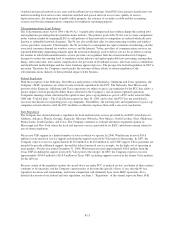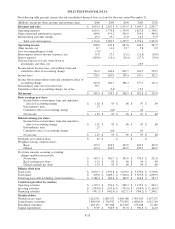Windstream 2006 Annual Report Download - page 125
Download and view the complete annual report
Please find page 125 of the 2006 Windstream annual report below. You can navigate through the pages in the report by either clicking on the pages listed below, or by using the keyword search tool below to find specific information within the annual report.
Interest Rate Risk
The Company’s earnings are affected by changes in variable interest rates related to Windstream’s borrowings under
its credit facilities, specifically the LIBOR rates. Under its current policy, the Company has entered into interest rate
swap agreements to obtain a targeted mixture of variable and fixed interest rate debt such that the portion of debt
subject to variable rates does not exceed 25 percent of Windstream’s total debt outstanding. The Company has
established policies and procedures for risk assessment and the approval, reporting, and monitoring of interest rate
swap activity. Windstream does not enter into interest rate swap agreements, or other derivative financial instruments,
for trading or speculative purposes. Management periodically reviews Windstream’s exposure to interest rate
fluctuations and implements strategies to manage the exposure.
As of December 31, 2006, the Company had entered into four pay fixed receive variable, interest rate swap agreements
on notional amounts totaling $1,562.5 million to convert variable interest rate payments to fixed. The four interest rate
swaps amortize quarterly to a value of $906.3 million at their scheduled termination on July 17, 2013. The weighted
average fixed rate paid by Windstream on these swaps is 5.604 percent, and the variable rate received by Windstream
is the three month LIBOR (London-Interbank Offered Rate). The weighted average variable rate received by the
Company was 5.37 percent at December 31, 2006. A hypothetical increase of 100 basis points in variable interest rates
would reduce annual pre-tax earnings by approximately $4.5 million. Conversely, a hypothetical decrease of 100 basis
points in variable interest rates would increase annual pre-tax earnings by approximately $4.5 million.
Critical Accounting Policies
We prepare our consolidated financial statements in accordance with accounting principles generally accepted in the
United States. Our significant accounting policies are discussed in detail in Note 1 to the consolidated financial
statements. Certain of these accounting policies as discussed below require management to make estimates and
assumptions about future events that could materially affect the reported amounts of assets, liabilities, revenues and
expenses and disclosure of contingent assets and liabilities. We believe that the estimates, judgments and assumptions
made when accounting for the items described below are reasonable, based on information available at the time they
are made. However, there can be no assurance that actual results will not differ from those estimates. These critical
accounting policies include the following:
In evaluating the collectibility of our trade receivables, we assess a number of factors including a specific customer’s
ability to meet its financial obligations to us, as well as general factors, such as the length of time the receivables are
past due and historical collection experience. Based on these assumptions, we record an allowance for doubtful
accounts to reduce the related receivables to the amount that we ultimately expect to collect from customers. If
circumstances related to specific customers change or economic conditions worsen such that our past collection
experience is no longer relevant, our estimate of the recoverability of our trade receivables could be further reduced
from the levels provided for in the consolidated financial statements. At December 31, 2006, our allowance for
doubtful accounts was $10.4 million. A 10 percent increase in this reserve would have increased the provision for
doubtful accounts by $1.0 million for the year ended December 31, 2006.
The annual costs of providing pension and other postretirement benefits are based on certain key actuarial assumptions.
As previously discussed, the discount rate selected is based on a review of current market interest rates on high-quality,
fixed-rate debt securities. The expected return on plan assets reflects management’s view of the long-term returns
available in the investment market based on historical averages of our actual returns and consultation with investment
advisors. The healthcare cost trend rate is based on our actual medical claims experience and future projections of
medical costs. See “Pension Plans” and “Other Postretirement Benefits” for the effects on our future benefit costs
resulting from changes in these key assumptions.
The calculation of depreciation and amortization expense is based on the estimated economic useful lives of the
underlying property, plant and equipment and finite-lived intangible assets. Although we believe it is unlikely that any
significant changes to the useful lives of our finite-lived intangible assets will occur in the near term, rapid changes in
technology or changes in market conditions could result in revisions to such estimates that could materially affect the
carrying value of these assets and our future consolidated operating results. In addition, as previously discussed, during
2006, 2005 and 2004, we reduced the depreciation rates on property, plant and equipment used in certain of our
markets based on studies of the related lives. We also intend to perform similar studies on the property, plant and
equipment used in certain of our remaining markets during 2007. We cannot predict what impact the results of those
studies will have on depreciation and amortization expense in 2007.
F-24
























